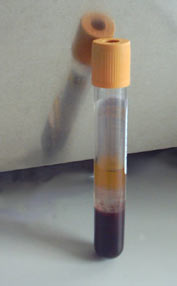Vacutainer
|
|
Vacutainerrainbow_small.jpg
Vacutainer® is a trademark of Becton, Dickinson and company for a kind of test tube designed for venipuncture.
Principles
The vein is first punctured with the hypodermic needle, which is connected to a translucent plastic holder. The needle actually has a second, smaller needle, and when a Vacutainer test tube is pushed down into the holder, its rubber cap is pierced. The vacuum in the tube sucks blood though the needle and fills itself. The tube is then removed and another can be inserted and filled the same way. It is important to remove the tube before withdrawing the needle, as there may still be some suction left, causing pain upon withdrawal.
The test tubes are covered with a colour-coded plastic cap. They often include additives that mix with the blood when collected (see below), and the colour of the tube's plastic cap indicates which additives that tube contains.
The plastic caps are opaque for tubes with a normal vacuum. Translucent-topped tubes contain a weaker vacuum in the same sized tube, and will obtain less blood. The weaker suction makes them more suitable for smaller sized veins. Because of the standardised suction of the tubes, they may cause the veins of elderly people, or those with delicate veins, to collapse. In this case a syringe should be used instead.
Contents of tubes
The tubes may contain additional substances that preserve the blood for processing in the medical laboratory. Using the wrong tube may therefore make the blood sample unuseable.The substances may include anticoagulants (EDTA, lithium citrate, heparin) or a gel with intermediate density between blood cells and blood plasma. When the tube is centrifuged, the blood cells sink to the bottom of the tube, are covered by a layer of the gel, and the plasma (or serum) is left on top. The gel enables the tube to be tipped upside-down, and transported without the blood cells remixing with the plasma.
- Red - Contains no additives. Tests for antibodies and drugs often require these.
- Gold - A serum-separating tube (SST). These contain particles that cause blood to clot quickly, as well as a gel to separate blood cells from serum. (Because the blood has clotted before it has been centrifuged, the liquid part is called serum not plasma.)
- Green - Contains the lithium salt of heparin, an anticoagulant.
- Purple or lavender - contains EDTA. This is a strong anticoagulant and these tubes are usually used for full blood counts and blood films.
- Grey - These tubes contain fluoride and oxalate. Fluoride prevents enzymes in the blood from working, so a substrate such as glucose will not be gradually used up during storage. Oxalate is an anticoagulant.
- Light blue - Contain a measured amount of citrate. Citrate is a reversible anticoagulant, and these tubes are used for coagulation assays. Because the liquid citrate dilutes the blood, it is important the tube is full so the dilution is properly accounted for.
- Dark Blue - Contains the sodium salt of heparin, an anticoagulant.
- Orange - These tubes contain thrombin which makes the blot clot extremely rapidly. This allows the serum to be analysed in a shorter time.
- Light yellow - Used in HLA phenotyping.
- Pink - Similar to purple tubes (both contain EDTA) these are used for ABO grouping and cross-matching.
Miscellaneous
The purple top tube became an issue in the O. J. Simpson murder trial when the defense alleged that small droplets of blood found at the crime scene contained the preservative EDTA; had this been true, it would have meant that the droplet might have been taken from the purple top tube used to collect Simpson's blood and planted at the crime scene.

